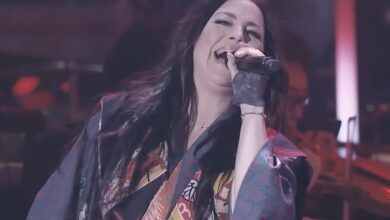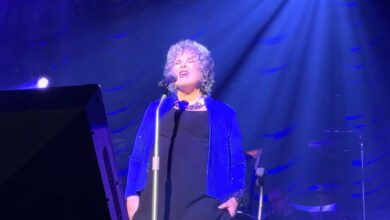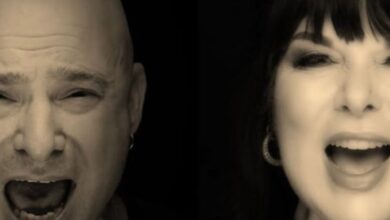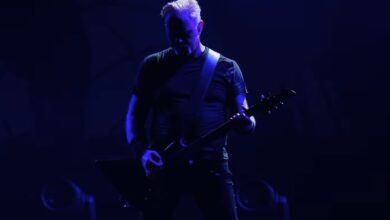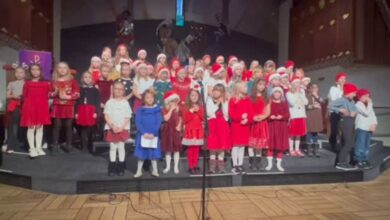Metallica’s “Enter Sandman” Live at Levi’s Stadium June 22, 2025 Crowned One of Their Greatest Performances in Recent Years
Metallica saved their most recognizable anthem for the final blow of their second Bay-Area “No Repeat Weekend,” and when the clean-guitar motif of “Enter Sandman” rippled across Levi’s Stadium, more than fifty-thousand voices roared as one. The giant sandman graphics shimmering across eight video towers framed a finale that felt equal parts homecoming, victory lap, and collective exorcism of pandemic-era frustration.
For hometown fans, the moment carried mythic weight. James Hetfield and Lars Ulrich still reminisce about those early East Bay rehearsal spaces where rent equaled today’s meal budget, and that history echoed through the crowd. Parents in faded Kill ’Em All shirts hoisted kids wearing neon-yellow 72 Seasons merch, proving that four decades of thrash can still unite generations under one gigantic chorus.
Staging such a reunion required an army of crew and gear. Eighty-seven semi-trucks hauled sixty-plus guitars, two complete drum kits, and miles of LED cabling into the stadium, turning the field into a miniature city. When ten flame cannons erupted during the final chorus, their heat briefly outshone the South Bay night sky, reminding everyone that Metallica’s production scale has kept pace with their ambition.
Musically, “Enter Sandman” remains a marvel of simplicity—one hypnotic riff, a lullaby twisted into nightmare, and a hook engineered for mass sing-along. Hetfield’s bark still slices through the wall of sound, propelled by Kirk Hammett’s wah-drenched dive-bombs and Robert Trujillo’s subterranean bass tone. Streaming fans accustomed to earbuds finally felt that iconic riff vibrating through their ribs instead of their phones.
The song’s enduring pull lies in its capacity to bridge eras. Toddlers wearing ear defenders scribbled “Sandman” in marker across their headsets while grandparents swapped memories of buying the Black Album on cassette in 1991. Few artists—let alone metal bands—manage that kind of multigenerational handshake, and Metallica does it without breaking stride.
Hetfield’s 2025 delivery balances grit with surgical control. He toyed with pauses before the “exit light” refrain, giving the crowd space to howl each syllable. Ulrich’s ride-cymbal crashes punched like exclamation points, every smash boosted by sub-bass rumbles that rattled beverage cups in the upper decks. Age has tempered neither the thunder nor the swagger.
Production values pushed sensory limits. During the whispered prayer—“Now I lay me down to sleep”—the entire stadium plunged into darkness save for a sea of phone lights, creating an impromptu constellation above the field. One heartbeat later, a blinding white strobe synced with Hammett’s descending solo, and the energy needle shot into the red.
Metallica loves a surprise, and this night’s twist came when Trujillo slipped in a tease of Cliff Burton’s chromatic fills from “(Anesthesia) Pulling Teeth.” The nod to their late bassist drew instant applause and underlined how Burton’s legacy still permeates Bay-Area lore, memorialized in murals along the I-880 corridor that snakes past the stadium.
Earlier in the set, deep cuts like “Ride the Lightning” and new scorchers such as “Lux Æterna” primed emotions, but Ulrich called “Sandman” the “communal exhale.” Once that final E-chord rang out, strangers high-fived, drained last sips of overpriced lagers, and swapped stories about seeing Metallica at Day on the Green or the old Cow Palace—moments stitched into local cultural fabric.
Philanthropy threaded through the spectacle. Mid-show, the band thanked fans for supporting the All Within My Hands Foundation’s Northern California wildfire relief, and a limited “Sandman Levi’s” poster sold out before the encore. By night’s end, merchandise revenue earmarked for charity had already crossed six figures, proving that heavy music’s biggest tour can flex heart alongside volume.
Online, clips of the performance exploded before house lights cooled. TikTok users pasted the riff over skateboard fails, puppy videos, and workout montages, while sports arenas from San Jose to Seoul piped the fresh recording into warm-ups within days. The track’s streams spiked, sending “Sandman” back onto rock charts in what label executives now call “The Sandman Bounce.”
The song has long transcended genre, echoing through college-football kickoffs, pro-wrestling entrances, and NATO air-show demos. Yet witnessing 55,000 hometown faithful scream the lullaby in person felt like reclaiming it from pop culture collage and returning it to its creators. For those minutes, every flame burst and pick scrape bound audience and band into one roaring organism.
Critics who dismiss stadium metal as mere nostalgia missed “Sandman’s” continued relevance. Its themes—fear of the unknown, loss of innocence—hit differently in an era grappling with AI hallucinations and climate anxiety. The fictional boogeyman evolves with each generation’s nightmares, keeping the track unsettlingly contemporary more than three decades after its birth.
As the final cymbal shimmered into silence, Hetfield blew a kiss to the South Bay sky and mouthed, “Goodnight, you beautiful family.” Fireworks streaked above, echoing punishing snare cracks, and the band disappeared down a corridor lined with vintage posters—a living museum of four decades spent making the improbable routine.
Long after, traffic crawled along Highway 101. Car windows down, fans drummed Ulrich’s fills on steering wheels while “Sandman” blasted from radios. Even in gridlock, that shared post-show pulse served as the truest encore—proof that the sandman will keep haunting California dreams for years to come, and Metallica’s nightmare lullaby shows no sign of sleeping.
